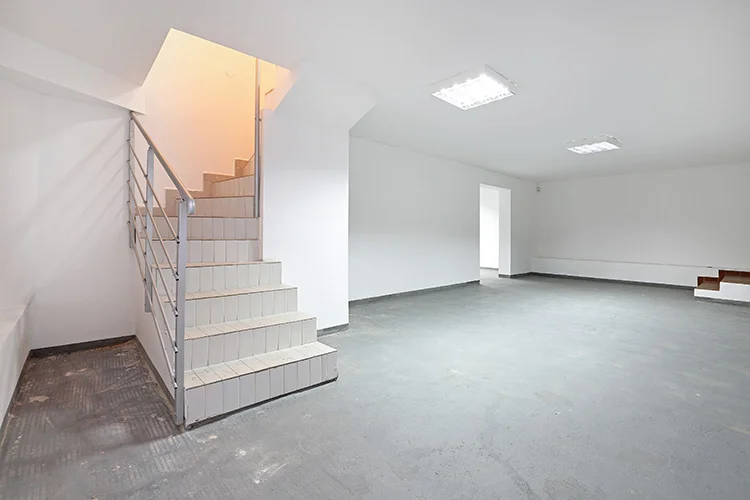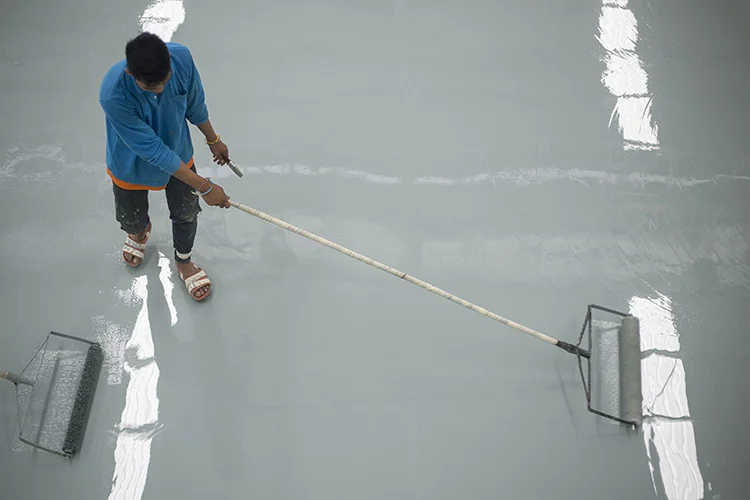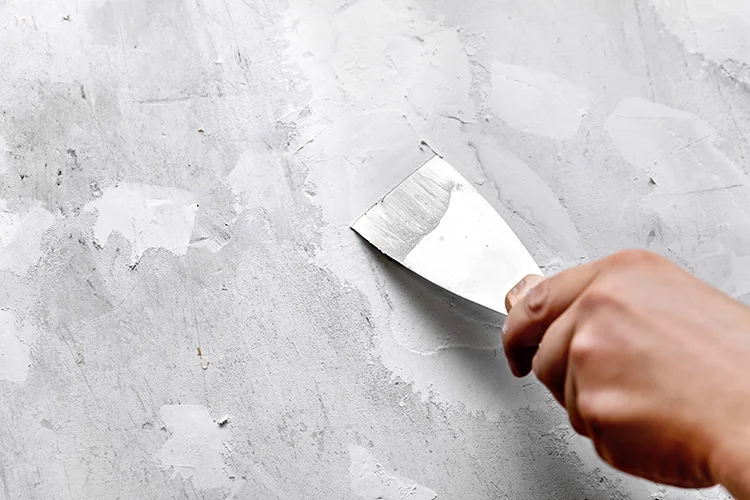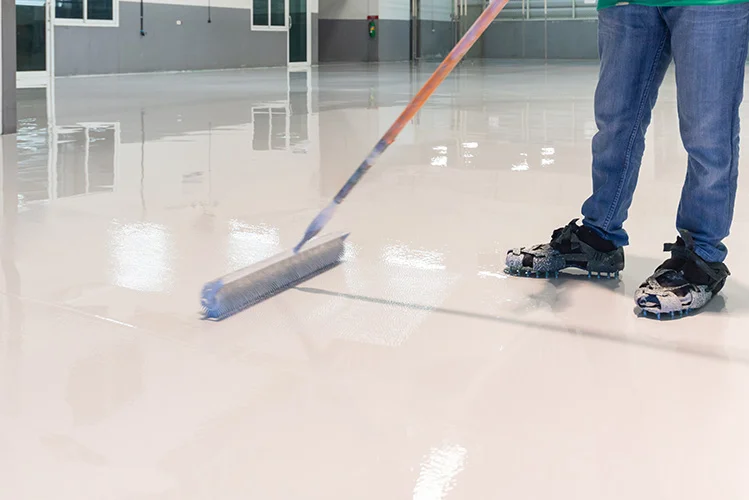Painting Concrete Floors

Painting Concrete Floors
Concrete floors are not only durable but also easy to install and maintain. But, the typical gray color of concrete can make basement floors seem cold and uninviting.
Painting concrete is one of the most popular ways to spruce up the basement floor. It is also a straightforward process that can add warmth and color to any concrete surface.
Step 1 – Cleaning and Priming Your Floor: Start by sweeping away any dirt or debris before priming your floor with our favorite primer.
Step 2 – Adding Color: Choose a basement paint color and apply it to the concrete floor.
Step 3 – Maintenance: Maintain your basement paint finish by sweeping and dusting daily.
Painting concrete floors can be an intimidating task, but it doesn’t have to be! This article walks you through the process and also what tools to use. We’ll cover everything from prep work, paint types, benefits, colors, and more!
Is Painting Concrete Floors a Good Idea?
Yes! It’s a great idea to paint concrete floors. Painting is one of the most popular ways to spruce up basement flooring. Concrete paints help mask the surface stains and the years of wear and tear. Moreover, it also extends the lifetime of the concrete by preventing further damage. It also comes in different colors, finishes, and formulas, depending on the type of surface.
How Long Does Painted Concrete Last?
Painting concrete floors is a great way to add color and interest. However, for long-lasting concrete paint, ensure that your floor is clean and dry before painting. You’ll also want to prime it with a primer first!
Depending on the kind of paint you use, the concrete paint can last anywhere from three years to five years! However, the lifetime depends on certain factors such as:
- Type of Paint
- Level of Footfall
- Exposure to Elements
- Quality of Paint
- Maintenance
Most brands suggest you apply a new coat every 3-5 years. A well-maintained concrete floor can help extend the lifetime of the paint. It shouldn’t be a problem since painted concrete is easy to maintain.
Does Painting Concrete Floors Make Them Slippery?
Painted concrete can be slippery when wet. The paints and sealers have a nonporous, and smooth coating that forms the external layer. This smoothens out the texture giving a slippery feel. Grits are added to the final coat of paint or concrete sealer, adding grip to the surface. Three common additives used to create texture are:
- Silica Sand
- Aluminum Oxide Beads
- Polymer Grits
Sand and aluminum beads are heavy and settle in the bottom. This doesn’t go well with the application, thereby reducing its effectiveness. On the other hand, polymer pieces are lightweight and go more even, making them a popular choice.
Benefits of Painting Concrete Floors
Painting concrete floors is not an easy job. Concrete is porous and can absorb paint and moisture. Hence it requires additional prep work to ensure that the paint adheres well. But, despite the work, a painted concrete can spruce up the place.
Here are the benefits of painting concrete floors:
- Prevents Moisture & Mold: Concrete being porous is notorious for rot, mold, and mildew. A painted floor can help prevent the moisture from seeping in, especially the basement floor.
- Easy Maintenance: Concrete floors are challenging to maintain. The surface being porous, the grease stains, dust, and debris are impossible to clean. However, concrete paint seals the pores, thereby making cleaning easy.
- Enhances the Appearance: Bare concrete slab can be grey and drab. A fresh coat of paint on the concrete floors can add visible warmth, color, and vibrancy to your basement or garage.
- Increases Safety: Concrete floors often have cracks and an uneven surface. Painted concrete can help reduce the risk, creating a visible, smooth, and even floor.
- Increases the Market Value: Painting the basement floor has an ROI of up to 70%, reflecting on the home’s resale value.
What Kind of Paint Do You Use When Painting Concrete Floors?

Whether you are painting your garage floor, basement floor, patio, or only your basement laundry room floor, it pays to know what paint to buy.
Epoxy paint is best suited for concrete floors since they are durable and can take a lot of abuse. It also holds better than latex paint. They work well for garage floors since they are resistant to oil, gasoline, and chemicals. However, they are not suitable for basements since they tend to attract moisture.
Acrylic paints are the cheapest option, but they don’t last long and can be challenging to clean up. The best choice would be concrete basement paint that comes with an epoxy or acrylic base. They are durable, easy to clean, and cost-effective without compromising on quality.
What Is the Best Color to Paint a Basement Floor?
It isn’t easy to choose basement floor paint colors as the basement has very little natural light. The best way to decide on color would be by asking yourself what you want out of your basement.
The most common choice, black, can give off an elegant appeal, but dark colors absorb more heat. White is the most popular basement color as they don’t absorb heat and reflect light well.
Teals, greys, blues, greens can help create a relaxing atmosphere in your basement. They do not absorb too much heat, which is excellent if you plan on entertaining guests.
TIPS:
- Before painting, test the colors on a hidden section of your basement to ensure you like them. This gives you an idea to test if they work well with the lighting in your basement.
- Choose a paint color that will help hide dirt. In addition, you want something easy to maintain.
- Also, keep into consideration the size of the room and the decor.
What Is the Best Way to Paint a Concrete or Basement Floor?
Concrete is not an easy surface to paint. It is porous, breathable, and also absorbs paint to an extent. However, the surface is pretty versatile, offering many options for repairs and improvements.
With the right tools, concrete floor materials, and techniques, you can turn a drab basement floor into a thing of beauty. The below steps can guide you to painting concrete floors.
Clear the Space
Before you paint, you must be able to see the floor. This will help you spot the issues like cracks firsthand. Spend time cleaning away what you don’t need. Donate, recycle or sell; do whatever works for you. Moving the remaining items into another room and create a space in your basement. Also, if the area is carpeted, remove the old carpet and area rugs to paint the concrete flooring.
Get Rid of the Gunk
Basement floors can also contain old paint splatters, adhesive, dirt, grime, and other substances. Paint can stick to these spots and make them stand out. Hence, you need to ensure that these are removed before the paint application.
Carpet glue is one of the strongest adhesives around and can be difficult to remove. Douse the glue with a lacquer thinner and then use a scraper to remove all the adhesive. You can also use the same method to scrape out gunk like hardened dirt and debris. Scraping doesn’t need to be backbreaking work if you use a scraper with a long extension pole.
Clean and Dry the Surface
New paint adheres better to a clean and dry surface. Start with a concrete degreasing product suitable for your floor (interior or exterior). These products are applied to damp floors. Hence you may want to use protective eyewear, gloves, and clothing before application
Then, use a floor cleaner to clean the basement concrete floors. Next, use a push broom to scrub the floor and vacuum using a shop vac. And let it dry thoroughly. It might take some time, but you will be able to see the spots where paint has been absorbed by the concrete.
Exterior surfaces like garage floors and patio floors can be easier to clean. First, wet the surface and spray the degreaser. Next, use a push broom to scrub the floor and wash it off with a garden hose. Finally, any stubborn rust spots left behind can be clean with a wire brush.
Fill Any Cracks and Holes

Cracks and holes should be filled before the painting concrete floor. Use a concrete filler for this step. It can flex with movement in case there is any settlement or shifting of the foundation after application. Use a putty knife to spread the filler over the cracks. Apply a second coat if needed and let it dry completely.
You can also use this time to fill any other holes in the concrete floor with a concrete patch or epoxy putty. You can find them at home improvement stores like Lowes or Home Depot. Again, let these products cure overnight before painting.
Holes in concrete basement floors can be hard to patch if the foundation has settled or shifted. This creates a gap between the concrete and bricks, stones, or rocks underneath. In such cases, remove any dirt from under these holes first with a wire brush.
Sand the Floor
Sand the entire surface of the concrete as the final step of prep work before priming. Sanding the rough areas ensures a smooth finish across the entire floor. Sweep or vacuum the dust with a construction vacuum or a shop vac. You do not want the dust to get under the paint as this will lead to peeling.
A clean floor is essential for the paint to adhere to the floor. Clean the basement floor with soap and water to ensure that it is free of dust. Keep in mind that there is no soap residue on the floor. Let it dry completely for 24 hours. Moisture on the floor can prevent the paint from adhering.
Use painter’s tape to mask off the walls and the baseboards along the edges of the room.
Prime After Painting Concrete Floors
A primer coat ensures that the paint sticks to the concrete floor. The primer that you choose should be compatible with both concrete and epoxy paints. Ensure that the primer you choose is fit for use in both interior or exterior concrete floors.
Use a paintbrush to apply the primer along the edges of the floor and cut in the edges. You can use the lambswool roller for the rest. Apply two coats and let dry for 24 hours.
Apply Epoxy Paint

Once the primer is dry, apply the concrete paint. Start from the farthest corner and work your way to the door. Apply the paint and let the first coat dry for 12 hours before painting a second coat. As a top coat, apply a concrete sealer over the painted basement floor.
In the case of epoxy paint, you’ll need to mix the two parts as mentioned in the label. Then, use the same process you used for the primer to apply the epoxy. Most epoxy paints need only one coat. (But you may want to check the label firsthand). Lastly, seal the floor with a concrete sealer compatible with epoxy paints.
Keep in Mind:
Fill the paint tray half full with paint. Next, load the roller with paint from the paint tray and roll the paint on the concrete floor.
Wash the roller and paintbrush with dish soap and hot water right after you’ve finished.
Follow the Manufacturer’s Instructions on Painting Concrete Floors
Ensure that you follow the manufacturer’s instructions regarding the temperature, ventilation, and humidity. The cure temperature and humidity are essential for a successful paint job. With the right combination of the factors above, you risk the paint lifting off within a year.
Painted Concrete Floor Care and Maintenance
Painted concrete floors are becoming quite famous due to their rustic, industrial-like appearance. They are easy to clean and maintain. However, they pose a unique problem. The painted surface is coated with a sealant to protect the paint underneath. Therefore, the cleaner that you use should not harm the integrity of the concrete.
Here are a few things you can follow to ensure a longer lifetime.
- Daily sweeping prevents dust accumulation. The buildup of dirt can scratch the surface of the concrete floor.
- A mild soap and water solution will work fine for daily cleaning. Use a damp microfiber mop to clean the floor. Avoid water pooling on the floor.
- Avoid using acid. Instead, use a diluted solution of vinegar. Vinegar not only cleans the floor but also prevents the growth of mold and mildew.
- Concrete floors should be resealed every two years to protect the paint job.
Conclusion
With the right paint, you can turn your basement floor into a bright and welcoming space. Painting is one of the most popular ways to spruce up basement floors, and it’s inexpensive and easy to apply. However, it has a long drying and curing process. You may have to wait as long as a week before walking on it again.
Depending on the type of paint and protective coat or sealant you use, painted concrete floors can last anywhere from three to five years! After that, you’ll have to top it up with a fresh coat of paint.
If you want a paint finish that lasts longer and looks more professional, then epoxy is the one. Epoxy is better than other paints because it can last longer and it looks good too. Besides, stained and painted concrete floors also improve the look of concrete.
Here at Wiese Painting, we have over 65 years of experience as professional industrial and commercial painters. We guarantee that any hard-to-paint color or surface, like concrete, is tackled with professionalism and tricks that have been acquired over the decades. You will love the look of your freshly-painted home or business, so contact us today for your free quote!









